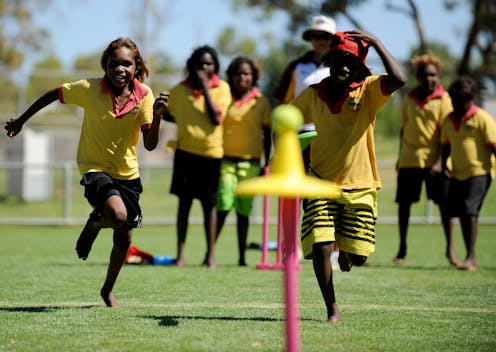Are sports programs closing the gap in Indigenous communities? The evidence is limited
- Written by Rona Macniven, Research Fellow, University of Sydney

Indigenous Australians have a long and proud heritage in both traditional sports and games, and in modern sport through the achievements of people like Johnathan Thurston and Ashleigh Barty.
There’s also long been the belief that sport can be used as a lever for improvement in outcomes for Indigenous communities. The 1987 Royal Commission into Aboriginal Deaths in Custody, for instance, found that sport and recreation can play a role in the reduction of offending behaviour among Indigenous peoples.
Read more: In both schooling and sport, Australia has slowly come to recognise its Aboriginal talent pool
And while there are a number of physical activity and sports programs for Aboriginal and Torres Strait Islander people today, a parliamentary inquiry in 2013 recommended that much more comprehensive evaluation of sports programs should be conducted to gauge their impact.
The report said some government sports programs
are being rolled out with very little understanding of how the Close the Gap outcomes are being achieved.
Another study noted that sport has often been seen as a “panacea” for myriad problems in Indigenous communities, and this belief has led to
ambitious, ill-defined and, in terms of evaluation, often elusive social outcome goals.
What could sport achieve?
To better understand the impact sport can have on Indigenous communities and how government investment could be better targeted, we undertook a review of 20 Australian studies published in peer-reviewed journals between 2003 and 2018.
The research looked at how sport and physical activity programs for Indigenous adults or children improved outcomes in six different areas:
1) education 2) employment 3) culture 4) social and emotional well-being 5) life skills 6) crime reduction
Because of the low level of evidence in this area so far, we included all relevant studies. The 20 studies involved over 2,500 individual participants located in urban, rural and remote areas across Australia.
Our review, which was published in the Journal of Science and Medicine in Sport, found some evidence that sport and physical activity increases Aboriginal and Torres Strait Islander school attendance, improves self-esteem and can enhance cultural connectedness, values and identity.
But the studies were inconclusive on whether sport and physical activity can have longer-term benefits, such as improving educational or employment outcomes or reducing crime.
Read more: The long and complicated history of Aboriginal involvement in football
Education
Eleven of the studies we reviewed examined education. Overall, most showed positive outcomes for young people involved in sport.
A number of programs were shown to improve school attendance, such as two AFL youth programs in Cape York and the Northern Territory aimed at encouraging school attendance and improving behaviour through Australian rules football.
Other programs showed improvements in school retention and achievement rates, while two helped Indigenous youth prepare for higher education and success beyond school.
Employment
Only one study examined the impact of sport on employment: the AFL youth program in the NT. Almost all of the participants and stakeholders felt the program helped players to secure paid work or training, but the study didn’t link to employment data specifically.
Culture
Nine studies examined culture. And like education, most programs showed positive outcomes for participants when it came to cultural connections, values and identity.
For example, in Victoria, the Fitzroy Stars community sports club study found that social and community connection was an important way for participants to strengthen and maintain their cultural values and identity.
And the study on the impact of the Swan Nyungar sports education program for young people in Perth found the success of participants depended on incorporating their families and culture in the instruction.
Social and emotional well-being
Twelve studies examined social and emotional well-being. Improved self-esteem and confidence were found in the participants of several programs, such as the WA Girls Academy and Indigenous surfing programs in several states.
A study of Queensland’s Deadly Choices program, which aims to help Indigenous people make healthier lifestyle choices, found that participants had increased confidence and were more proactive about preventing chronic disease.
Life skills
Five studies examined “life skills.” The positive outcomes ranged from improved attitudes and lifestyle choices ([the AFL Cape York program]) to hygiene and health, self-reliance and fundraising skills (the WA Girls Academy).
Crime
Only five studies examined the impact of sport on crime prevention and prison inmate management, and the findings were limited.
The Aboriginal Power Cup, another youth football program in South Australia, was found to have positive impacts when it came to school achievement, but the study didn’t directly examine aspects of crime.
A study into a prison sport program in central Australia found that it was an effective diversion for inmates, but there were only six participants in the study, which is not a very robust sample size.
Meanwhile, the impact of the NT AFL program on community safety and violence was unclear, as was the impact of a sports program in Arnhem Land that aimed to steer Indigenous youth away from substance abuse.
This is a key challenge for researchers in this area – identifying the specific impacts of sport and physical activity programs on societal problems such as crime in which many factors come into play.
Read more: Radical rethink of Closing the Gap required, despite some progress
More evidence is needed
Substantial challenges remain in accurately measuring how sports programs like these can lead to better outcomes for Indigenous communities. Scoping reviews, for instance, do not include an assessment of study quality and therefore may overestimate the findings.
More studies are needed to track the impact of sport through a range of indicators. We also still need to know more about how programs can improve employment and crime outcomes.
With more robust evidence, a more targeted plan can be made for future programs that are better suited to the needs of individual communities.
Authors: Rona Macniven, Research Fellow, University of Sydney





